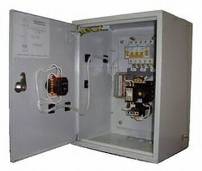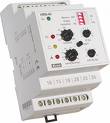Types of electrical protection of asynchronous electric motors
Protection of asynchronous electric motors
 Three-phase AC asynchronous motors with a voltage of up to 500 V at powers from 0.05 to 350 — 400 kW are the most common type of electric motors.
Three-phase AC asynchronous motors with a voltage of up to 500 V at powers from 0.05 to 350 — 400 kW are the most common type of electric motors.
The reliable and uninterrupted operation of electric motors is ensured above all by their correct selection in terms of nominal power, mode of operation and form of execution. No less important is the observance of the necessary requirements and rules when composing an electric circuit, choosing control equipment, wires and cables, installation and operation of the electric drive.
Emergency modes of operation of electric motors
Even for properly designed and operated electric drives, during their operation there is always the possibility of occurrence of emergency or abnormal modes of motor and other electrical equipment.
Emergency modes include:
 1) multiphase (three- and two-phase) and single-phase short circuits in windings of an electric motor; multiphase short circuits in the terminal box of the electric motor and in the external power circuit (in wires and cables, on the contacts of switching devices, in resistance boxes); phase short circuits to the housing or neutral wire inside the engine or in an external circuit — in networks with a grounded neutral; short circuits in the control circuit; short circuits between turns of the motor winding (turn circuits).
1) multiphase (three- and two-phase) and single-phase short circuits in windings of an electric motor; multiphase short circuits in the terminal box of the electric motor and in the external power circuit (in wires and cables, on the contacts of switching devices, in resistance boxes); phase short circuits to the housing or neutral wire inside the engine or in an external circuit — in networks with a grounded neutral; short circuits in the control circuit; short circuits between turns of the motor winding (turn circuits).
Short circuits are the most dangerous emergency conditions in electrical installations. In most cases, they occur due to insulation damage or overlap. Short-circuit currents sometimes reach values that are tens and hundreds of times higher than the values of the currents in normal mode, and their thermal effect and the dynamic forces to which live parts are subjected can lead to the failure of the entire electrical installation ;
2) thermal overload of the electric motor due to the passage of increased currents through its windings: when the working mechanism is overloaded for technological reasons, especially severe starting conditions, motor under load or stalled, long-term reduction in mains voltage, loss of one of the phases of the external power supply circuit or wire breakage in the motor winding, mechanical damage in the motor or the operating mechanism, and thermal overloads with deteriorated motor cooling conditions.
Thermal overloads primarily cause accelerated aging and destruction of the engine insulation, which leads to a short circuit, that is, to a serious accident and premature failure of the engine.
Types of protection for asynchronous electric motors
Protective measures are provided to protect the engine from damage in the event of violation of normal operating conditions, as well as timely disconnection of the defective engine from the network, thus preventing or limiting the development of an accident.
The main and most effective means is the electrical protection of the motors, carried out in accordance with «Rules for the construction of electrical installations» (PUE).
Depending on the nature of the possible faults and abnormal operating modes, there are several basic most common types of electrical protection of asynchronous motors.
 Protection of asynchronous motors from short circuit
Protection of asynchronous motors from short circuit
Short-circuit protection shuts down the motor when short-circuit currents occur in its power (main) circuit or in the control circuit.
Devices that provide protection against short circuits (fuses, electromagnetic relays, circuit breakers with electromagnetic release) act almost immediately, that is, without a time delay.
Overload protection of asynchronous motors
 Overload protection protects the motor from unacceptable overheating, especially even with relatively small but long-term thermal overloads. Overload protection should only be used for electric motors of these operating mechanisms where abnormal increases in load are possible in the event of operating process disturbances.
Overload protection protects the motor from unacceptable overheating, especially even with relatively small but long-term thermal overloads. Overload protection should only be used for electric motors of these operating mechanisms where abnormal increases in load are possible in the event of operating process disturbances.
Overload protection devices (temperature and thermal relays, electromagnetic relays, automatic switches with thermal release or with a clock mechanism) when an overload occurs, they turn off the motor with a certain delay, the greater the less the overload, and in some cases with significant overloads, and immediately.
Protection of asynchronous electric motors from shortage or disappearance of voltages
Protection against low or low voltage (zero protection) is carried out with the help of one or more electromagnetic devices, it acts when turning off the motor in the event of a power failure or when the mains voltage drops below the set value and protects the motor from spontaneous switching on after eliminating the interruption of the power supply or restoration of normal mains voltage.
Special protection of asynchronous electric motors against two-phase operation protects the motor from overheating, as well as from "rollover", that is, stopping under current due to a decrease in the torque developed by the motor when one of the phases of the main circuit is interrupted. The protection operates when the engine is started.
Thermal and electromagnetic relays are used as protection devices. In the second case, the protection may not have a time delay.
Other types of electrical protection of asynchronous motors
There are some other, less common types of protection (against overvoltage, single-phase earth faults in networks with an isolated neutral, increasing the speed of rotation of the drive, etc.).
Electrical devices used to protect electric motors
Electrical protection devices can apply one or more types of protection simultaneously. For example, some circuit breakers provide short-circuit and overload protection. Some of the security devices, for example fuses, are single-acting devices and require replacement or recharging after each actuation, others, such as electromagnetic and thermal relays, are multi-acting devices. The latter differ in the way they return to standby for self-tuning and manual reset devices.
Selection of the type of electrical protection of asynchronous electric motors
 The choice of one or another type of protection or several at the same time is made in each specific case, taking into account the degree of responsibility of the drive, its power, operating conditions and maintenance procedure (presence or absence of permanent maintenance personnel).
The choice of one or another type of protection or several at the same time is made in each specific case, taking into account the degree of responsibility of the drive, its power, operating conditions and maintenance procedure (presence or absence of permanent maintenance personnel).
The analysis of data on the accident rate of electrical equipment in the workshop, on the construction site, in the workshop, etc., revealing the most frequently repeated violations of the normal operation of engines and technological equipment, can be of great benefit. You should always strive to ensure that the protection is as simple and reliable as possible in operation.
Any motor, regardless of its power and voltage, must be protected against short circuits. The following circumstances should be considered here. On the one hand, the protection must be disabled by the starting and braking currents of the motor, which can be 5-10 times higher than its rated current.On the other hand, in a number of short-circuit cases, for example in winding circuits, short-circuits between phases near the neutral point of the stator winding, short-circuits to the box inside the motor, etc., the protection must operate at currents of -low from starting current.
It is difficult to meet these conflicting requirements simultaneously with simple and inexpensive remedies. Therefore, the protection system of low-voltage asynchronous motors is built on the deliberate assumption that with some of the above-mentioned faults in the motor, the latter is not disconnected from the protection immediately, but only during the development of these faults, after the current consumed by the motor from network has increased significantly.
One of the most important requirements for engine protection devices — its clear action in emergency and abnormal engine operation modes and at the same time the inadmissibility of false alarms. Therefore, protective devices must be properly selected and carefully adjusted.
